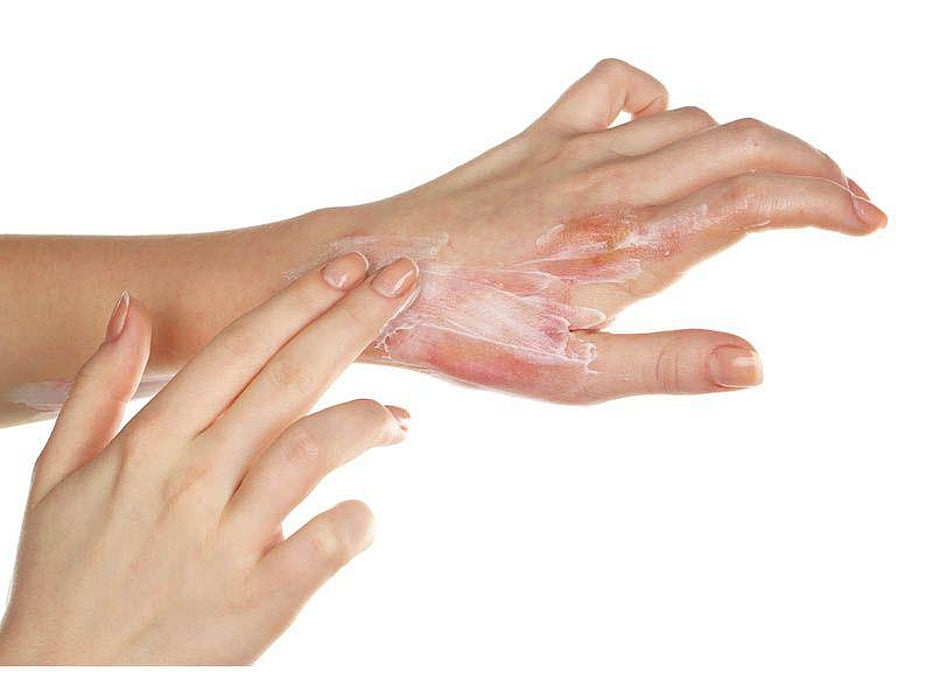Chemical Burns

Many people associate chemical burns with factories, but they can happen at home, too: Contact with strong chemicals found around the house, the garage, or at work can burn your skin or eyes. Examples of dangerous substances are battery acid, bleach, paint strippers, drain cleaners, and even everyday household cleaning supplies like ammonia. Just being exposed to the fumes of some chemicals can cause a burning sensation in the eyes, nose, or throat. Prompt action can stop chemical burns, limit injury, and speed healing.
Signs and symptoms that may accompany chemical burns
- Burn marks or blisters on the skin
- Headache
- Abdominal pain
- Difficulty breathing
- Seizures
- Dizziness or loss of consciousness
- Watery or red eyes
- White in the colored part of the eye (the iris)
- Eyes sensitive to light
What to do
First, get away from the source of the chemical. Then remove any items of clothing or jewelry that may have come into contact with the chemical, so you will prevent further burning. Caution: If the chemical is a powder, such as lime, use a cloth to brush as much as you can off the skin. Don't use your hands or you may further burn your skin.
Next, rinse the affected skin with water. For burns on arms or legs, place the burned area under running water for at least 20 minutes to flush off the chemical. If large sections of skin, especially on the torso, have been exposed, use a shower or garden hose to rinse the chemical off.
Special instructions for chemical burns to the eye
If the eye is affected, flush it under a running faucet. Don't worry about finding sterile water -- any source of clean water will do. The most important thing is flushing out the chemical. Position the head so that the affected eye is below the other eye. This will help you avoid washing chemicals into your other eye. Another option is to fill a sink or dishpan with water and immerse the face or the affected eye. Open and close your eyelids under water, moving the eye around to make sure water reaches every part. You may want to change the water several times.
Continue flushing with water for 20 to 30 minutes. Flush longer if the burning sensation persists. Once the chemical has been completely washed off, cover the burned area, including the affected eye or eyes, with a clean cloth or bandage.
When to seek medical help
If more than one quarter of the skin area of any part of the body -- your whole forearm, for example -- or face has made contact with a strong or caustic substance, call your doctor or go to an emergency medical facility immediately.
Call your doctor or get to an emergency medical facility if any very strong or caustic chemical such as lye or paint stripper has made contact with the eye. Also seek medical assistance if an affected eye remains painful after 30 minutes of flushing. Once the pain subsides and the chemical has been entirely flushed from the eye, it's still important to monitor for any unusual signs or symptoms. If the affected eye shows signs of persistent redness, discharge, or watering, or if vision is affected in any way, including sensitivity to light, call your doctor or go to an emergency medical facility immediately.
Be sure to take the chemical container with you to the emergency room or write the chemical name on a slip of paper. Knowing the chemical will help emergency personnel determine how best to treat the burn. If you are unsure whether the substance is dangerous, call the poison control center at 1-800-222-1222.
How to prevent chemical burns
Always follow the directions for use on chemical bottles and packages. Wear rubber gloves and/or eye protection as directed whenever you are using strong chemicals at home, in the garage, or at work.
When shopping for household cleaners and other supplies, carefully read labels. Try to choose the least caustic or strong chemicals for your purpose, or use nontoxic alternatives such as a baking soda, salt, and white vinegar mixture to loosen clogged drains. And once you are done with chemicals like paint strippers or lye, get rid of them. Many communities have toxic waste round-ups that allow you to dispose of strong or potentially dangerous chemicals safely. If you have children, store all strong chemicals where they can't be reached. That often means locking them in a storage cabinet.
References
Handbook of First Aid and Emergency Care, American Medical Association
American College of Emergency Physicians, First Aid Manual
The American Red Cross First Aid & Safety Handbook
United States Consumer Product Safety Commission. Household batteries can cause chemical burns. http://www.cpsc.gov/cpscpub/pubs/5088.html
United States Consumer Product Safety Commission. What you should know about using paint strippers. http://www.cpsc.gov/cpscpub/pubs/423.html
MedlinePlus. Medical Encyclopedia: Chemical burn or reaction. U.S. National Library and the National Institutes of Health. http://www.nlm.nih.gov/medlineplus/ency/article/000059.htm
United States Environmental Protection Agency. Drain cleaners. http://www.epa.gov/grtlakes/seahome/housewaste/house/draincl.htm
United States Environmental Protection Agency. Learn about chemicals around your house. http://www.epa.gov/kidshometour/index.htm
United States Environmental Protection Agency. Alternative household and garage cleaning products. http://www.purdue.edu/dp/envirosoft/housewaste/src/open.htm
Healthwise Handbook. Chapter 3: First aid and emergencies. http://www.permanente.net/handbook/healthwisehandbook/ch_03/ch_03_chemical_burns.htm
Mayo Clinic. Chemical Burns First Aid. http://www.mayoclinic.com/health/first-aid-chemical-burns/fa00024
Pokhrel P. et al. Ocular Emergencies. American Family Physician. Volume 76, Number 6. S
Related Posts
Twins Study Shows Exercise Altering How Genes Behave
FRIDAY, Dec. 9, 2022 (HealthDay News) -- One might expect identical twins to...
Vinculan un uso intenso de antibióticos con el desarrollo de enfermedad de Crohn y colitis
VIERNES, 13 de mayo de 2022 (HealthDay News) -- Mientras más antibióticos toman...
Oil & Gas Production Takes Toll in U.S. Lives, Health Costs
MONDAY, May 8, 2023 (HealthDay News) -- Pollutants produced by the U.S. oil and...
Rocatinlimab Effective for Moderate-to-Severe Atopic Dermatitis
THURSDAY, Dec. 15, 2022 (HealthDay News) -- The anti-OX40 antibody rocatinlimab...
